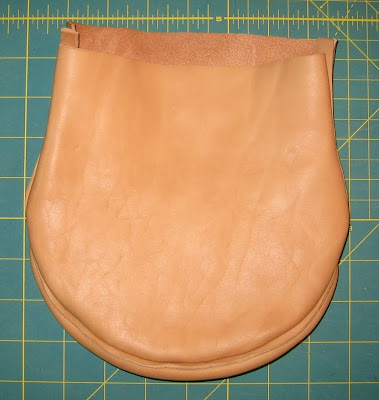The bag hangs on a strap that's 2" wide, from left shoulder to right hip. The strap is made of a long piece with holes in it (like a belt) and a shorter piece with a buckle. The differences in lengths keeps the buckle off the wearer's shoulder. Here's the buckle:

The powder horn attaches to the strap using it's own buckles. These are situated so they're about 8" above the bag.

Here's a close-up of one of the powder horn's buckles - it accepts a 1/2" wide strap.

Once the straps have been stitched on, the front flap is stitched on. It's stitched through the back of the bag as well as the straps, strengthening them. That's why the flap goes on last.

Here's the completed, unstained pouch. The straps still need to be cut to length.


And here it is, stained, with my reluctant model.

And Dottie and the left, Spice on the right.

Spice Girl!

After it was done we found out it's nearly too small. If I make another I'll make it wider. And the alcohol in the dye stiffened the leather considerably. It was horrible. I pretty much soaked the bag in neatsfoot oil and worked it like a baseball glove until is softened. It's usable now and will get better over time.
I wasn't too happy with the dye. It left lots of streaks. By the time I got the streaks evened out the bag was darker than I wanted. Still looks ok. But I think I'll try a different dye next time. The book I linked in Part 1 gives a recipe made of iron and vinegar. I think I'll experiment with it.
In any event, we're ready for the range!







